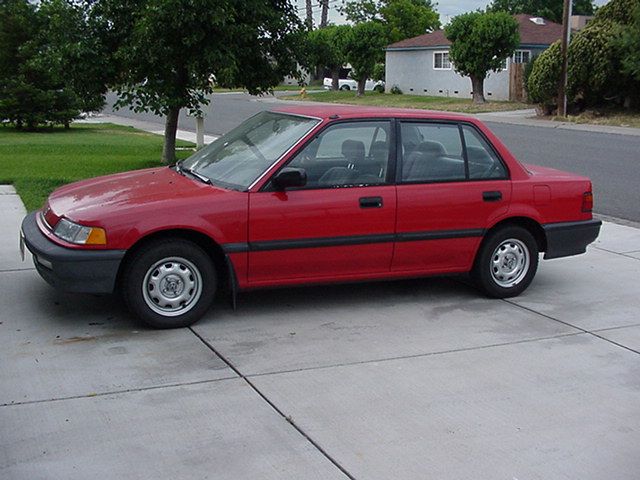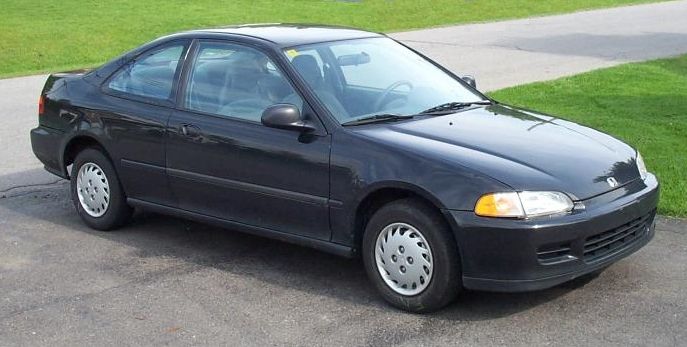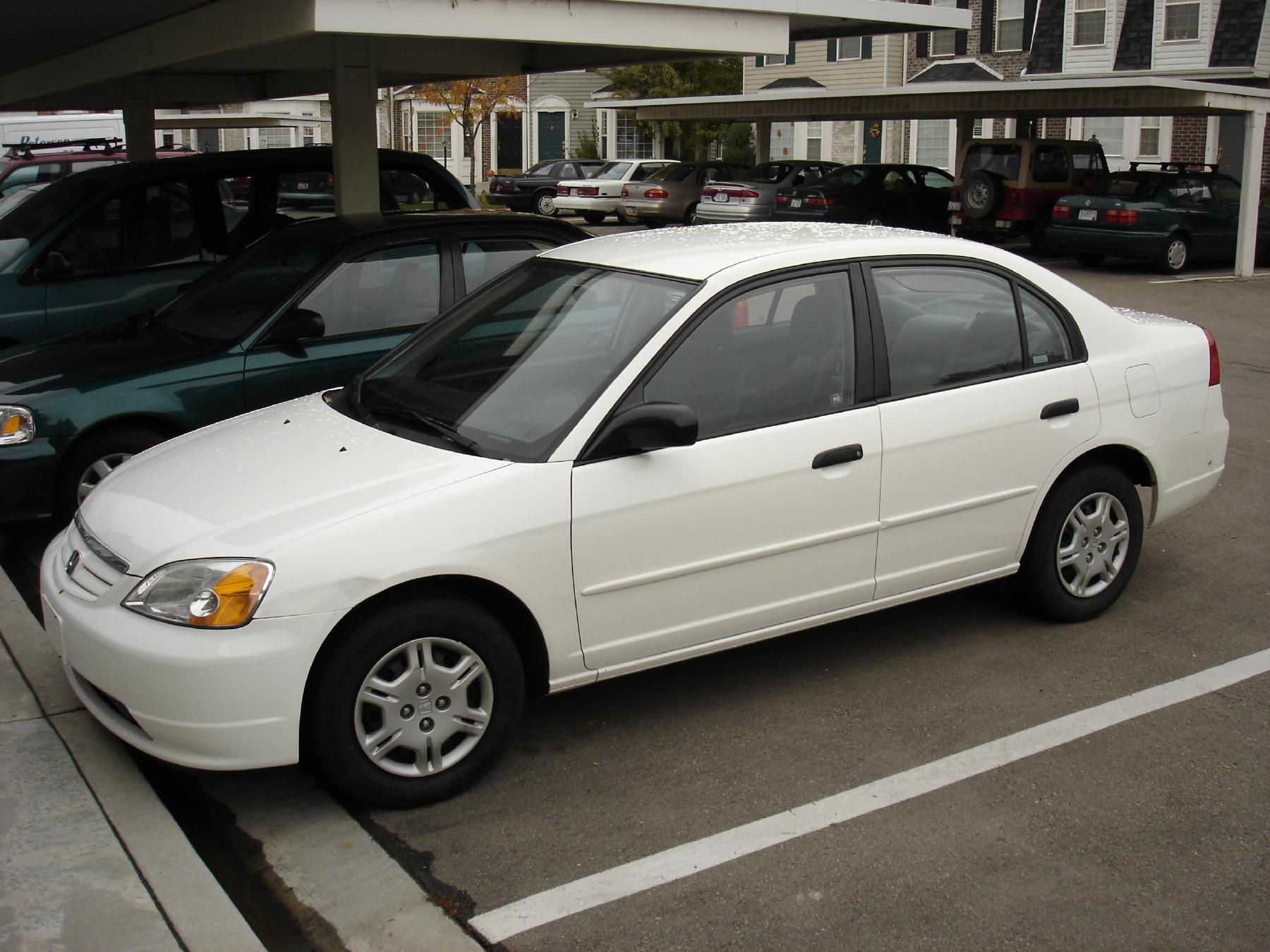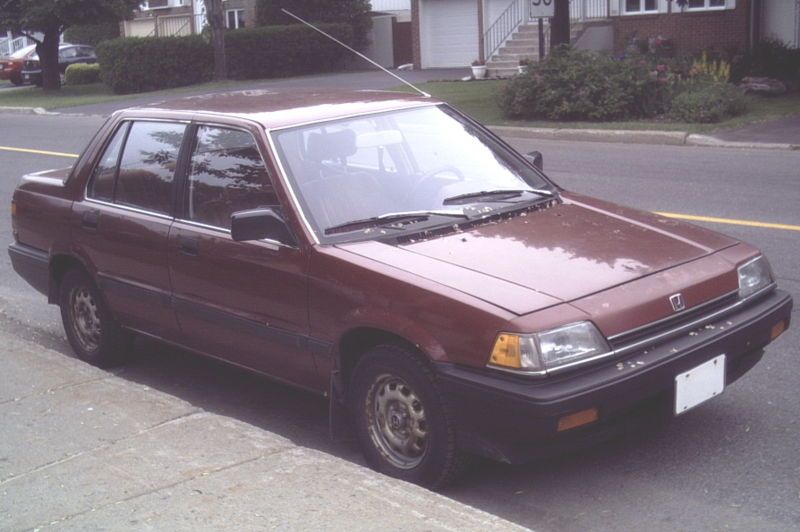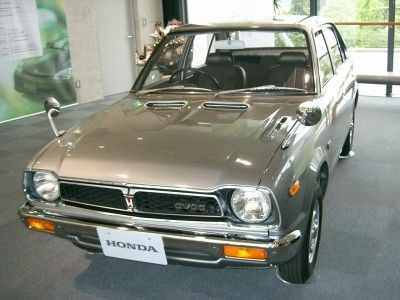The Honda Civic is an automobile manufactured by Honda. It was introduced in July 1972 as a two-door coupe, followed by a 3-door hatchback version that September. With the transverse engine placement of its 1169 cc engine and front wheel drive, like the British Mini, the car provided good interior space despite overall small dimensions.
Early models of the Civic were typically outfitted with a basic AM radio, rudimentary heater, foam cushioned plastic trim, two-speed wipers, and painted steel rims with a chromed wheel nut cap. The current Civic has become much more luxurious with satellite-linked navigation, a six-speed manual, power locks and power windows available. Still, many regard the Civic as representing a good value for the money, combining good performance, reliability and economy, as well as a very low rate of depreciation.
1973 - 2006 Honda Civic History
- Make: Array
- Model: 1973 - 2006 Honda Civic History
- [do not use] Vehicle Model: Array
History
1973-1979
Prior to 1973, Honda was a company known more for its motorcycles than for its cars, which were tiny two-cylinder 600cc runabouts. This changed when the Civic debuted for 1973. The Civic offered amazing space efficiency in a fun little car that achieved more than 40 mpg on the highway. Room for four passengers was quite a feat for a car that possessed such diminutive dimensions as an 86.6-inch wheelbase and 139.8-inch overall length. A small transversely mounted engine and front-wheel-drive layout (an arrangement that was something of a novelty to the American car market) and 12-inch wheels maximized interior room. Indeed, early ads for the Civic boasted that it had more passenger room than many larger cars. Two similar body styles were available, a hatchback and a "sedan." These Civics were identical, even the rear of the cars looked the same, except that one had a hatchback and the other had a small vertical panel that opened to allow access to the "trunk." The early Civic had a few style quirks, such as turn signal lights that looked as if they were added on after the car was already built and a bulging center divider in the grille. Standard equipment included power front disc brakes, vinyl seating, reclining bucket seats and a wood-grain-accented dashboard. The hatchback added a fold-down rear seat, AM radio and cloth upholstery. Options were minimal, consisting of air conditioning, an automatic transmission, radial tires and a rear wiper for the hatchback.
A 1,169cc (or about 70-cubic-inch) inline four-cylinder engine motivated the first-year Civic and put out 50 horsepower. This was an impressive output when considered in terms of power per unit of displacement: The Civic had 0.71 horsepower per cubic inch. And with a weight of only around 1,500 pounds, a whole lot of power wasn't needed to propel the Civic. Transmissions offered included a four-speed manual or a two-speed "Hondamatic" automatic gearbox. An all-independent suspension made the Civic an agile econobox that could run circles around American-built competitors like the Ford Pinto and Chevrolet Vega.
The Civic's base price was around $2,200 and Honda's early slogan, "It will get you where you're going," emphasized the practical and economical mission of the Civic and made no pretenses otherwise.
For 1974, the Civic's engine size grew slightly, to 1,237 cc and power went up to 52 horsepower. In order to meet the new 5-mph bumper impact standard, the Civic's bumpers grew, as did its overall length, which was now 146.9 inches.
The CVCC (or Controlled Vortex Combustion Chamber) engine debuted in 1975. Offered alongside the standard Civic engine, the 53-horsepower CVCC engine displaced 1,488 cc and had a head design that promoted cleaner, more efficient combustion. The CVCC design eliminated a need for a catalytic converter or unleaded fuel to meet emissions standards. (Nearly every other U.S. market car for this year underwent the change to exhaust catalysts and the requirement to use only unleaded fuel.) Due to California's stricter emissions standards, only the Civic CVCC was available in that state. A five-speed manual gearbox became available this year, as did a Civic station wagon (only with the CVCC engine), which had a wheelbase of 89.9 inches and an overall length of 160 inches. Civic sales topped 100,000 units for this year.
1978 brought slight cosmetic changes, such as a black grille, rear-facing hood vents (that replaced the sideways versions) and new turn signals. The easiest way to tell a '78 from an earlier example is to look at the front signals: Prior to 1978, they looked like foglights mounted in the Civic's grille, whereas in 1978 they were smaller and mounted under the bumper. The CVCC engine was now rated at 60 horsepower.
Apart from a minor increase in horsepower that brought the base engine to 55 horsepower and the CVCC to 63 ponies, little changed for the 1979 Civic.
-----
1980-1983
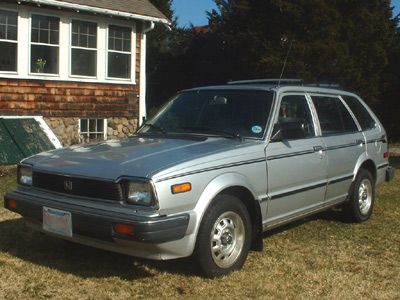
A new, sleeker body and increases in wheelbase and base-model engine size marked the 1980 Civic. The wheelbase now measured 88.6 inches for the hatchback (the two-door "sedan" was dropped) and 91.3 inches for the wagon. All Civic engines now used the CVCC design; the base 1,335cc ("1300") engine made 55 horsepower, while the 1,488 ("1500") produced 67 horsepower. Three transmissions were offered: a four-speed manual (on base models), a five-speed manual and a two-speed automatic.
The Civic 1300 and 1500 came in base and DX versions, and the latter featured a five-speed manual, rear window defroster, intermittent wipers and a cigar lighter. The 1500 GL added radial tires, a rear window wiper/washer, tachometer, clock and bodyside moldings. The Civic wagon came in a single version that was tantamount to the DX trim level.
A four-door sedan debuted for 1981, as did a three-speed automatic transmission that replaced the primitive two-speed unit.
Rectangular headlamps and black bumpers appeared on the 1982 Civic. A new gas-sipping model, the five-speed "FE" (Fuel Economy) was introduced and was rated at 41 mpg in the city and 55 mpg on the highway.
The sporty new Civic "S" replaced the 1500 GL in 1983 and was fitted with a firmer suspension (with rear stabilizer bar) and 165/70R13 Michelin tires. A red accent encircled the S and set it apart from the other Civics.
1984-1987
The third generation Civic, introduced in September, 1983 consisted of 4 body styles, with only the 3-door Hatchback and the 4-door Sedan having interchangeable panels. The 3-door Hatchback now rode on a 238 cm wheelbase; the 4-door Sedan, also called Honda Ballade, and built in England as Rover 213/216 (June, 1984) rode on a 245 cm wheelbase. The Wagon was now called Shuttle and used the same 245 cm wheelbase. The Civic CR-X, called Ballade Sports in Japan was a 3-door Coupe, riding on a 220 cm wheelbase and was already introduced in June, 1983.
All cars had a new front and rear suspension, torsion bars instead of coils in front, and a torsion beam axle with coil springs at the rear. By November, 1984 a 4-wheel-drive version arrived for the Shuttle with a live rear axle, by September, 1986 the system became permanent. A derivative was the Quint Integra, which arrived as a 3-door Hatchback on a 245 cm wheelbase in February, 1985. In November, 1985 came the 5-door Hatchback on a 252 cm wheelbase, and in October, 1986, in Japan a 4-door Sedan on the same 252 cm wheelbase.
-----
1988-1991
A sleeker and more powerful Civic lineup debuted in 1988. All Civics (except the CRX) rode on a longer 98.4-inch wheelbase. The CRX's wheelbase was increased to 90.6 inches.
A lower hoodline, increased glass area and lower wind drag were functional advantages of the sleeker body styles. A family of new engines complemented the stylish Civics. Power for the DX hatchback/sedan, new LX sedan and the wagon came from a 1.5-liter 16-valve engine that produced 92 horsepower. The base hatchback had a less powerful 70-horsepower version of that engine. The fuel-economy champ CRX HF had an eight-valve 62-horse version of the 1.5 that could go up to 56 miles on a gallon of gas. The standard CRX had the 92-horse engine. A high-performance 1.6-liter 16-valve engine that kicked out 105 horsepower was installed in the CRX Si and Civic 4WD wagon. All Civic engines were now fuel injected. Previously, only the "Si" models had the injection.
A double-wishbone suspension system was used at all four wheels. Inspired by Formula One race cars, this design promoted agile handling and a comfortable ride by precisely controlling wheel travel and keeping the tire's contact patch square to the road surface.
One model departed (the Civic Si hatchback), as a new one, the Civic LX sedan, was introduced. The LX loaded up a Civic sedan with features such as power windows, locks and mirrors; a tachometer; and intermittent wipers. U.S. production for the Civic began this year in Ohio, making it easier for Honda to satisfy America's appetite for its gem of a small car.
The Civic Si hatchback returned for 1989, now with a power moon-roof and once again with the same potent engine (increased to 108 horsepower for this year) installed in the CRX Si and the 4WD wagon.
Revised bumpers and taillights identified the 1990 Civic. Hatchbacks received larger reverse (white) lights, and sedans adopted a horizontal taillight theme. An EX sedan joined the Civic family and took its place at the top of the sedan lineup. The EX had the Si's engine, 14-inch wheels and all the features of the LX (which now included cruise control). Four-wheel disc brakes appeared on the CRX as did a slightly revised dash-board (with softer corners and larger instruments) for all Civic models.
The 1991 Civics were virtually unchanged, and this was the last year for the spunky CRX.
1992-1995
By November, 1992 the Honda Domani 4-door Sedan arrived with different body, also sold as Isuzu Gemini from August, 1993. This car was built in England as Rover 400 with different roof end from May, 1995, where a 5-door Hatchback was developed, which was also sold as Honda Civic in Europe. These cars were rebadged Rover 45 by January, 2000 when they received a nostalgic front. By spring 1998 a 5-door Wagon arrived, as Honda Civic Aerodeck in Europe. The new Integra 3-door Coupe and 4-door Pillared Hardtop arrived in May, 1993 and rode on a 257 cm and 262 cm wheelbase respectively.
1996-2000
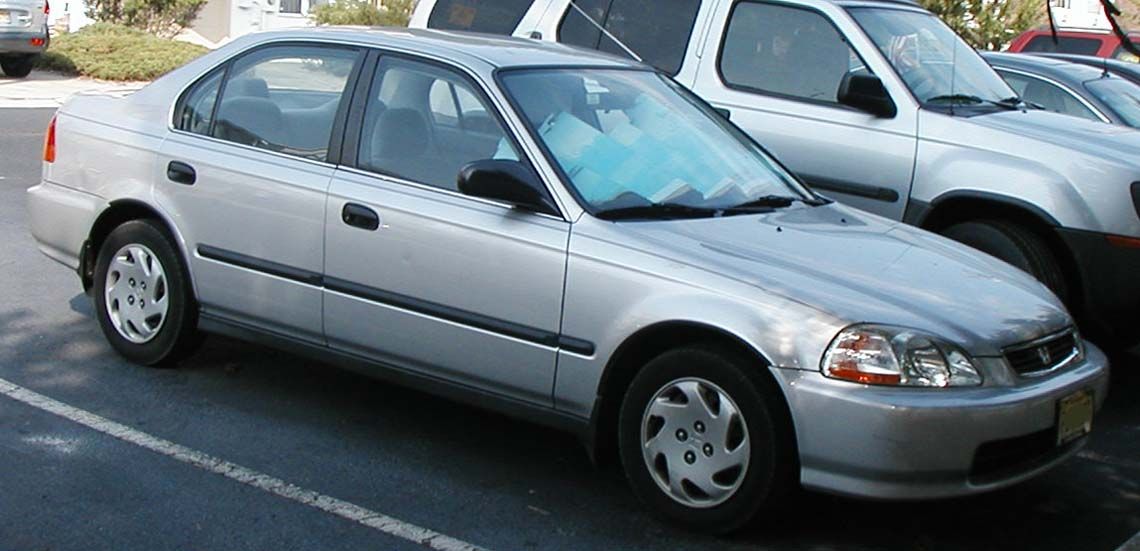
A revamped Civic lineup debuted for 1996. The new body featured larger light clusters fore and aft, a grille (chrome-accented on sedans) and a crisp character line that ran the length of the car. Hatchbacks now had the 103.2-inch wheelbase of the coupes and sedans, and overall length was up around 2 to 4 inches, depending on body style.
Sedans were again offered in DX, LX and EX trim levels. A new coupe, the HX, joined the DX and EX coupes. The HX coupe essentially replaced the VX hatchback, offering high mileage figures from a fairly powerful engine. The revised VTEC-E engine (now at 1.6 liters) in the HX put out 23 more horsepower (for a total of 115 ponies) than the previous version but now "only" scored mileage figures of 39 in the city and 45 on the highway. A gearless continuously variable automatic transmission (CVT) that promised seamless performance and manual-transmission fuel economy was introduced later in the year as an option for the HX. The hatchback lineup was trimmed down to two models, the CX and DX. A new 1.6-liter 106-horsepower engine that earned Low Emission Vehicle (LEV) certification powered the CX, DX and LX, and a slightly more powerful 127-horsepower VTEC-assisted version was found in the EX models.
Excluded from the redesign, the del Sol was now in its fourth year and got a host of tweaks to keep it current. The base model (S) got the new 1.6-liter 106-horse engine fitted to the new Civic, Si models got the beefier suspension of the VTEC, and all versions got a freshened front fascia.
In 1997, all Civics came with 14-inch wheels, DX models got full wheel covers, the LX sedan received air conditioning and, strangely, EX coupes with manual transmissions no longer had the option of antilock brakes. As this would be the last year for the del Sol, Honda made no changes.
Not much happened in 1998, save for new wheel covers, an exterior handle for hatchbacks and the addition of map lights.
A slightly revised front fascia and taillights, along with redesigned climate controls updated the Civic for 1999. A "Value Package" for the DX sedan debuted that included features that most buyers wanted, such as air conditioning, a CD player, power door locks, automatic transmission and keyless entry, at a substantial savings when compared to the separate option prices.
Midway through the year to the joy of pocket-rocket enthusiasts everywhere, the Civic Si returned, now in the coupe body style and sporting a potent 160 horsepower from its 1.6-liter VTEC engine. A firmer suspension, front strut tower brace, 15-inch alloy wheels wearing 195/55R15 rubber and four-wheel disc brakes completed the hardware upgrades for the Si. A front spoiler, side sills and subtle bodyside graphics set the Si apart from the other Civic coupes, and the standard equipment was generous and similar to that of the EX.
Other than the shuffling of paint choices, the Civic stood pat for the year 2000.
2001-2005
The biggest news is the availability of a Hybrid Civic sedan, which has a more powerful gas/electric power plant system than in Honda's groundbreaking Insight. This environmentally friendly vehicle offers the room and comfort of a Civic sedan with mileage estimates of 46 mpg in the city and 51 mpg on the highway. Although Toyota brought out its four-door Prius hybrid a few years prior to this Civic's debut, Honda loyalists now have a practical hybrid they can call their own.
There are now three body styles to choose from: coupe, sedan and hatchback. Conservative styling for the sedan and a slightly more aggressive approach for the coupe help to differentiate these two body styles, while the hatchback presents a snub-nosed, city-car look. The hatch is only available as the sporty 160-horsepower Si, while the others are available in familiar DX, HX (coupe only), LX and EX trim levels.
A more spacious cabin features Honda's trademark large, simple controls but greater use of hard plastic trim seems to indicate that the company may be resting on its laurels a bit.
The newest Civics ride on a stiffer platform that decreases chassis flex and thus provides better handling and increased crash protection. But to the chagrin of hard-core enthusiasts, Honda replaced the front double-wishbone suspension setup with a more space-efficient McPherson-strut setup, which isn't as easy to "slam" (lower) as the double-wishbone design. Steering now boasts a quicker ratio along with variable power assist, which makes parking easier while allowing more road feel and response during spirited driving.
Under the hood, the engine's size has been increased slightly (from 1.6 to 1.7 liters) to provide more torque, and transmissions were tweaked for improved shifter feel and greater efficiency.
Current (2006- )
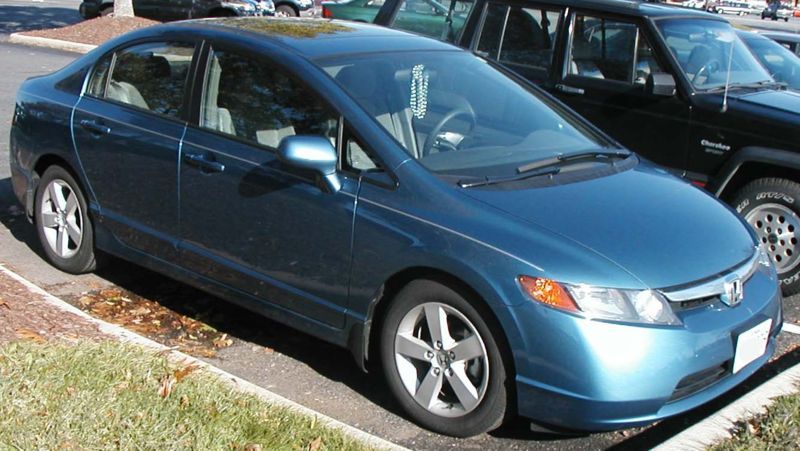
The DX model is the base model that comes equipped with LATCH, immobilizer theft-deterrent system, power windows, daytime running lights (DRL), 15" wheels with covers, driver's seat height adjustment, and other features (All Canadian sold Civics have the 160 watt stereo system). The LX model adds a 160 watt 6-speaker stereo system, air conditioning, 16" wheels with covers (Alloy wheels in Canadian LX models), cruise control, MP3/audio jack (Coupe only), passenger side walk in (with memory) , floor mats, security system with remote entry and Canadian sold models (except for DX) include heated exterior mirrors. The EX model adds an optional voice-activated navigation system, a moon-roof, 4 wheel disc brakes, 16" alloy wheels, 2 12-volt accessory outlets (instead of one), a 350 watt stereo system with 7 speakers (Coupe only, the Sedan EX comes with a 160 watt stereo system), exterior temperature indicator, rear cup holders with rear arm rest, and MP3/audio jack.
The Coupes come standard with a rear spoiler and on the ex models (only) have chrome finish on the exhaust pipe. They are typically a bit sportier than their Sedan counterparts and cost $200 cheaper at base MSRP. It should be noted that the EX model of both the Coupe and Sedan are actually a bit smaller, in terms of interior room (because of the sunroof, which takes up head-room), than their DX and LX counterparts. MSRP is US$14,360 for the DX Manual Coupe to approximately $19K for the Si model.
A manual transmission is no longer offered for the 2006 Honda Civic Hybrid and gains more power, plus a mileage boost to an EPA estimated 50 mpg city/highway.
The American market Civic Si is a special trim level designed to offer a sportier experience than the standard Civic. It offers a more powerful engine, 6-speed manual transmission, sport seats, and different styling. The engine is a 2.0-liter, DOHC four-cylinder design with Honda's i-VTEC variable valve timing system. It produces 197 hp (200 PS/147 kW), 57 more than the Civic sedan. A 350 Watt, seven speaker sound system is also included along with a helical limited slip differential, close ratio 6 speed gearbox, and unique Si cloth seats.
All Civics (including their trims) have unique covers/wheels specific to their car and all come in cloth with no leather option. Additionally they feature a new "two-tier" design. MPH/KPH, water temperature, and fuel is displayed at the top while the lower tier displays the tachometer. The brightness on these displays can be adjusted. The Civic Si changes the backlight from blue to red while the Hybrid features IMA Assist and Charge indicators on its display.
During the Civic Tour of the Black Eyed Peas (BEP), Honda is holding a contest for a BEP customized Honda Civic Hybrid. Included in this customized hybrid are leather seats, custom paint job featuring BEP-type graphics, custom installed 55SH Shure microphone, a $10,000 Alpine multimedia system that includes a DVD player, navigation, touch screen 7" widescreen display, 700 watt speaker system with 2 10" subwoofers powered by 2 V12 amps, two type-S speakers, XM Satellite Radio, 18" Koenig rims, Dunlop Direzza DZ101 tires, sportier Sprint suspensions that lowers the vehicle by 2", and a custom exhaust tip. The engine itself and other internal parts are identical to the Hybrid itself.
It is interesting to note that the BEP trim of the Honda Civic Hybrid comes with a public address system, a novel feature, but illegal in most United States jurisdictions for non-emergency vehicles. The total value of the car is presumably close to $37,000.
For the Brazilian market, the eighth generation Civic is available only with a Sedan body, and it is externally almost identical to the USDM version, having different bumpers and a higher ground clearance. It is available in three trim levels. The LXS and EXS levels are equipped with the 1.8L i-VTEC SOHC engine generating 140 HP at 6300 rpm. Both models might be equipped with a 5-speed manual or a 5-speed automatic transmission, but only the EXS has the paddle shift controls on the steering wheel. The LX trim is a special model, based on the LXS, available only for handicapped individuals and has its power restricted to 125 ps and automatic transmission, in order to be eligible for special tax breaks. The 2006 Civic received the "Best Buy" award from Quattro Rodas magazine, the most prestigious car magazine in the country. The recommended prices for 2006 Civics in Brazil range from R$61.745,00 to 80.750,00, but due to high demand, new Civics are being sold for about 10% more than the recommended price. The Si Sedan was announced at Salão do Automóvel in São Paulo, it will feature a 2.0L i-VTEC SOHC at 192 HP.
For the JDM and ASEAN markets, the new Civic has slight but noticeable styling differences from the American version. However, the JDM-styling is available in Canada as the Acura CSX. While the arcing line sweeping across the front fascia is retained, the main headlights dip away from the main arc for a more sporty appearance. The front bumper also has more vents with a steeper angle and sharper corners than the USDM Civic. Meanwhile, the taillights, which in the USDM Civic resemble those of an Audi A4, are more reminiscent of the Integra, with the main round brake lights dipping slightly down into the indicators. On the interior side, the JDM/ASEAN Civic will have contrasting two tone color scheme. The three spoke steering wheel from the USDM Civic Si and the European hatchback is standard. Engines include a 1.8 liter SOHC i-VTEC engine that produces 140 hp at 6300 rpm and a 2.0 liter DOHC i-VTEC engine that produces 155 hp at 6200 rpm, both are mated to either a 5-speed manual or 5-speed automatic (with paddle shifting available on the 2.0L model) with drive by wire throttles. A hybrid version is also available.
The European Civic is the most different in that it will be offered as 5-door and 3-door hatchbacks only. Mechanically, the European Civic differs from the USDM and JDM variants in that it uses a simpler torsion beam suspension system for the rear wheels compared to the double-wishbone system in the USDM and JDM Civics. This change happened in this generation to allow the car to keep its large interior space, and actually reduce the length of the outgoing model Civic. Externally, the European model is the most aggressively styled, while the sweeping front arc is maintained, while a Perspex cover that looks very much like a light replaces the grille. The rear tail lights are also similarly styled. Triangular accents are found front and back, with triangular fog-lamps in front and dual triangle exhaust tips at the back. The rear back-glass is split into two levels, divided by a spoiler lip and the fuel filler cap is a race inspired exposed metal cap. For the 5-door models, the rear door is hidden away, with the door handles tucked away at the corners of the rear windows, creating the illusion of a 2 door coupe. Inside, the Euro Civic follows the same split level theme, but with a slightly racier design with circular A/C vents and switchgear. There's also a start button reminiscent of the Honda S2000. The handbrake is in a more conventional position behind the shift lever. All around there is a generous use of metallic trim. Engines include the 1.8 liter i-VTEC shared with the USDM and JDM models as well as a 2.2 liter i-CDTi turbodiesel. A 6-speed manual transmission is available across the range. An automated manual transmission, known as I-SHIFT is available for the petrol engine models. Some other features of the European Civic include 'magic seats' in the rear, that not only lay flat to increase boot capacity, but also allow the seat bench to lift up and lay flat against the back rests to create a large loading area in the back behind the front seats. There is also a 'hidden' storage compartment in the boot under the floor. The lid, which normally forms part of the boot floor, can be sunk down to a lower level to increase the load area, designed to allow the boot area accommodate larger or taller items. In the normal position, the storage area can be used to hide valuables away under the floor. Some models in the range feature things like electric folding mirrors, a panoramic glass roof, and automatic headlights and windscreen wipers. The range topping EX model also has DVD satellite navigation, and allows the car's entertainment system, climate control, navigation system and hands-free telephone system to be controlled all by voice commands.
Awards
The Civic was Motor Trend's Import Car of the Year for 1980, as well as its 2006 Car of the Year. The Civic has been on Car and Driver magazine's annual Ten Best list six times, in 1985, 1988 through 1991, and 1996. The Civic GX, a natural gas version of the vehicle was named Greenest Car of 2005 by the American Council for an Energy Efficient Economy. Honda claimed 5 of the top 10 Greenest car slots, 3 of which were models of the Civic. The Civic Si was named "Best New Sport Car" and the sedan was named "Best New Economy Car" in the 2006 Canadian Car of the Year awards. The Civic also won the North American Car of the Year and the North American International Auto Show (NAIAS) Car of the Year awards for 2006.
Believed to be the best Civic ever made, the sixth generation model won at least three awards since it was launched.
One of the 10 Best Cars of Car and Driver magazine
Automobile magazine's Automobile of the Year
Japanese Car of the Year
Racing

The Civic has been used in a wide variety of racing series, particularly in Japan. It is also used in touring car races in Europe and the United States. In the U.K the Civic is used in the BTCC with synchro motorsport, and in endurance series such as barwell motorsport and cartek motorsport. In 2002 Honda entered the BTCC with a works effort to win the title in the new Civic type r. In Japan many endurance series teams also use the Civic. In 2002 Jas motorsport entered the ETCC with a Super-2000 spec Civic.
NCAP results
- (1982-1983) - "worse than average" level of occupant protection
- (1984-1987) - "significantly worse than average"
- (1988-1991) - "worse than average"
- (1992-2004) - "average"


